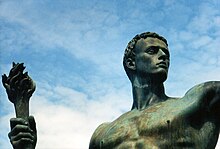Raca mjeshtërore

Raca mjeshtërore (gjermanisht: Herrenrasse) është një koncept pseudoshkencor në ideologjinë naziste në të cilin "raca ariane" e supozuar konsiderohet kulmi i hierarkisë racore njerëzore.[1] Anëtarëve u referoheshin si "Herrenmenschen" ("njerëz mjeshtërorë").[2]
Teoricieni nazist Alfred Rosenberg besonte se "raca nordike" e kishte prejardhjen nga proto-indo-evropianët, të cilët ai besonte se kishin banuar parahistorikisht në Rrafshin e Gjermanisë Veriore dhe mund të kishin origjinën përfundimisht në ishullin e humbur të Atlantidës.[3] Nazistët deklaruan se arianët ishin superiorë ndaj të gjitha racave të tjera dhe besonin se ata kishin të drejtë të zgjeroheshin territorialisht.[4] Politika e vërtetë që u zbatua nga nazistët rezultoi në certifikatën ariane. Ky dokument, i cili kërkohej me ligj për të gjithë qytetarët e Rajhut, ishte "çertifikata ariane e vogël" (Kleiner Ariernachweis) dhe mund të merrej përmes një Ahnenpass, i cili kërkonte që pronari të gjurmonte prejardhjen e tyre përmes pagëzimit, certifikatave të lindjes ose dëshmive të certifikuara se të gjithë gjyshërit ishin me "prejardhje ariane".
Sllavët, romët dhe hebrenjtë u përkufizuan si "Untermenschen" nga pikëpamja racore dhe joariane, dhe kështu konsideroheshin si një rrezik për racën zotëruese ariane ose gjermanike.[5] Sipas Planit të Urisë sekrete naziste dhe Planit të Përgjithshëm të Lindjes, popullsia sllave duhej të largohej nga Evropa Qendrore përmes dëbimit, skllavërisë, urisë dhe shfarosjes,[6] me përjashtim të një përqindjeje të vogël që konsiderohej se ishin pasardhës josllavë të kolonëve gjermanikë, dhe kështu të përshtatshëm për gjermanizim.[7]
- ^ Bryant, Edwin; Bryant, Edwin Francis; Bryant, Professor of Hinduism Edwin (2001). The Quest for the Origins of Vedic Culture: The Indo-Aryan Migration Debate (në anglisht). Oxford University Press, US. ISBN 978-0-19-513777-4.
- ^ Michaelis, Meir (qershor 1972). "World Power Status or World Dominion? A Survey of the Literature on Hitler's 'Plan of World Dominion' (1937–1970)". The Historical Journal. Cambridge University Press. 15: 331–360. doi:10.1017/S0018246X00002624. JSTOR 2638127.
{{cite journal}}: Mungon ose është bosh parametri|language=(Ndihmë!) - ^ Rosenberg, Alfred, The Myth of the 20th Century. The term Atlantis is mentioned two times in the whole book; the term Atlantis-hypothesis is mentioned just once. Rosenberg (p. 24): "It seems to be not completely impossible, that at parts where today the waves of the Atlantic ocean murmur and icebergs move along, once a blossoming land towered in the water, on which a creative race founded a great culture and sent its children as seafarers and warriors into the world; but if this Atlantis-hypothesis proves untenable, we still have to presume a prehistoric Nordic cultural center." Rosenberg (p. 26): "The ridiculed hypothesis about a Nordic creative center, which we can call Atlantis – without meaning a sunken island – from where once waves of warriors migrated to all directions as first witnesses of Nordic longing for distant lands to conquer and create, today becomes probable." Original: "Es erscheint als nicht ganz ausgeschlossen, dass an Stellen, über die heute die Wellen des Atlantischen Ozeans rauschen und riesige Eisgebirge herziehen, einst ein blühendes Festland aus den Fluten ragte, auf dem eine schöpferische Rasse große, weitausgreifende Kultur erzeugte und ihre Kinder als Seefahrer und Krieger hinaussandte in die Welt; aber selbst wenn sich diese Atlantishypothese als nicht haltbar erweisen sollte, wird ein nordisches vorgeschichtliches Kulturzentrum angenommen werden müssen. ... Und deshalb wird die alte verlachte Hypothese heute Wahrscheinlichkeit, dass von einem nordischen Mittelpunkt der Schöpfung, nennen wir ihn, ohne uns auf die Annahme eines versunkenen atlantischen Erdteils festzulegen, die Atlantis, einst Kriegerschwärme strahlenförmig ausgewandert sind als erste Zeugen des immer wieder sich erneut verkörpernden nordischen Fernwehs, um zu erobern, zu gestalten."
- ^ Hitler, Adolf Mein Kampf 1925
- ^ Longerich 2010.
- ^ Snyder 2010.
- ^
Janusz Gumkowski and Kazimierz Leszczynski. "Hitler's Plans for Eastern Europe". Warsaw: Polonia Publishing House. fq. 7–33, 164–78. Arkivuar nga origjinali më 6 nëntor 2011.
{{cite web}}: Mungon ose është bosh parametri|language=(Ndihmë!)
